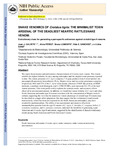Mostrar el registro sencillo del ítem
Snake venomics of crotalus tigris: the minimalist toxin arsenal of the deadliest neartic rattlesnake venom: evolutionary clues for generating a pan-specific antivenom against crotalid type II venoms
| dc.creator | Calvete Chornet, Juan José | |
| dc.creator | Pérez, Alicia | |
| dc.creator | Lomonte, Bruno | |
| dc.creator | Sánchez, Elda | |
| dc.creator | Sanz, Libia | |
| dc.date.accessioned | 2014-04-08T17:27:15Z | |
| dc.date.available | 2014-04-08T17:27:15Z | |
| dc.date.issued | 2012-02-03 | |
| dc.identifier.citation | http://pubs.acs.org/doi/abs/10.1021/pr201021d | |
| dc.identifier.issn | 1535-3893 | |
| dc.identifier.other | essn: 1535-3907 | |
| dc.identifier.uri | https://hdl.handle.net/10669/11039 | |
| dc.description | artículo (arbitrado)-- Universidad de Costa Rica, Instituto de Investigaciones Clodomiro Picado. 2012. This document is the Accepted Manuscript version of a Published Work that appeared in final form in Journal of Proteome Research, copyright © American Chemical Society after peer review and technical editing by the publisher. To access the final edited and published work seehttp://pubs.acs.org/doi/abs/10.1021/pr201021d | es |
| dc.description.abstract | We report the proteomic and antivenomic characterization of Crotalus tigris venom. This venom exhibits the highest lethality for mice among rattlesnakes and the simplest toxin proteome reported to date. The venom proteome of C. tigris comprises 7–8 gene products from 6 toxin families: the presynaptic β-neurotoxic heterodimeric PLA2, Mojave toxin, and two serine proteinases comprise, respectively, 66% and 27% of the C. tigris toxin arsenal, whereas a VEGF-like protein, a CRISP molecule, a medium-sized disintegrin, and 1–2 PIII-SVMPs, each represents 0.1–5% of the total venom proteome. This toxin profile really explains the systemic neuro- and myotoxic effects observed in envenomated animals. In addition, we found that venom lethality of C. tigris and other North American rattlesnake type II venoms correlates with the concentration of Mojave toxin A subunit, supporting the view that the neurotoxic venom phenotype of crotalid type II venoms may be described as a single-allele adaptation. Our data suggest that the evolutionary trend towards neurotoxicity, which has been also reported for the South American rattlesnakes, may have resulted by paedomorphism. The ability of an experimental antivenom to effectively immunodeplete proteins from the type II venoms of C. tigris, C. horridus, C. oreganus helleri, C. scutulatus scutulatus, and S. catenatus catenatus, indicated the feasibility of generating a pan-American anti-Crotalus type II antivenom, suggested by the identification of shared evolutionary trends among South American and North American Crotalus. | es |
| dc.description.sponsorship | Financed by grants BFU2010-17373 (from the Ministerio de Ciencia e Innovación, Madrid, Spain), CRUSA-CSIC (project 2009CR0021), and PROMETEO/2010/005 from the Generalitat Valenciana (Valencia, Spain), NIH/VIPER resource grant (#5 P40 RR018300-09), and Texas A&M University-Kingsville. | es |
| dc.language.iso | en_US | es |
| dc.publisher | Journal of Proteome Research 11(2): 1382–1390 | es |
| dc.subject | Sustancia peligrosa | es |
| dc.subject | Veneno de serpiente | es |
| dc.subject | Snake venom | es |
| dc.subject | Proteomics | es |
| dc.subject | Venomics | es |
| dc.title | Snake venomics of crotalus tigris: the minimalist toxin arsenal of the deadliest neartic rattlesnake venom: evolutionary clues for generating a pan-specific antivenom against crotalid type II venoms | es |
| dc.type | artículo original | |
| dc.identifier.doi | doi:10.1021/pr201021d | |
| dc.description.procedence | UCR::Vicerrectoría de Investigación::Unidades de Investigación::Ciencias de la Salud::Instituto Clodomiro Picado (ICP) | es |
Ficheros en el ítem
Este ítem aparece en la(s) siguiente(s) colección(ones)
-
Microbiología [1171]


